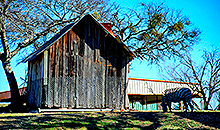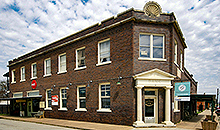Main Menu
Ellis County Data
Ellis County Communities & Places
Genealogy & History Links by USGHN
Important Ellis County Addresses
Sponsors
Ellis County Neighbors
Dallas County, Texas
Henderson County, Texas
Hill County, Texas
Johnson County, Texas
Kaufman County, Texas
Navarro County, Texas
Tarrant County, Texas
Other Websites
Welcome to Ellis County Texas Genealogy & History Network!
Welcome to the Ellis County, Texas Genealogy & History Network. Our purpose is to provide visitors with free resources for genealogical and historical research. To share your genealogy or history information, send an email to txghn@outlook.com and we will happily include it here. For other Texas Counties, visit the Texas Genealogy & History Network state website and go to the appropriate county. Thanks for visiting and good luck with your research! |
|
About Ellis County, Texas...

Ellis County is located in north central Texas. Waxahachie, the largest town and county seat is thirty miles south of Dallas. Away from the streams it is almost treeless except for scattered mesquite, cacti, and shrubs. Native trees such as ash, cottonwood, pecan, hackberry, bois d'arc, oak, and elm grow along watercourses. The area is well drained by many streams that flow into the Trinity River, which forms the eastern boundary of the county. Red Oak, Waxahachie, Mill, and Chambers creeks drain most of the county.
Tonkawa Indians were the earliest inhabitants of the future county, though parties of Wacos, Bidais, Anadarkos, and Kickapoos often hunted in the area. Spanish missionaries worked with the Tonkawas, and as the American settlers began to move into the region in the middle of the nineteenth century the Indians offered little organized resistance. By 1859 the Tonkawas had been removed to Oklahoma.
One of the first settlers in the area was William R. Howe, who settled late in 1843 near the site of present Forreston. Howe immigrated under the Peters colony project. The Southerland Mayfield family settled at Reagor Springs in February 1844, and the Billingsly family located near Ovilla later that year.
The state legislature officially established Ellis County on December 20, 1849. It was drawn from Navarro County, organized in February of the following year, and probably named for Richard Ellis, president of the Convention of 1836. Waxahachie was named the county seat.
 A boundary dispute with Johnson County was temporarily settled during Reconstruction, when Ellis County ceded nearly 100 square miles of land. The argument resurfaced in the late 1880s and was finally peaceably settled by a new survey of the line in 1939.
A boundary dispute with Johnson County was temporarily settled during Reconstruction, when Ellis County ceded nearly 100 square miles of land. The argument resurfaced in the late 1880s and was finally peaceably settled by a new survey of the line in 1939.
The early settlers of Ellis County came predominantly from the southern part of the United States, bringing their farming methods and their slaves. A number of Czechs (Bohemians), Hungarians, and Germans settled in the county during the 1850s. The most profitable business was cattle raising because of the mild climate and the native grasses covering the fertile prairies. The first settlers generally took land along the streams and raised some small grains to use at home or to trade for lumber in East Texas.
Ellis County found itself deeply embroiled in the secession crisis. Waxahachie citizens formed a chapter of the Knights of the Golden Circle, and in the fall of 1860 rumors of slave insurrections in Waxahachie and in nearby communities led to the lynching of a number of blacks and alleged antislavery whites. In January 1861 Amzi Bradshaw and T. C. Neel represented Ellis County at the state Secession Convention in Austin. The following month the citizens of the county overwhelmingly supported secession. The Confederate government operated a powder mill in Waxahachie and a hat factory near the site of present Italy during the Civil War.
In 1868 J. W. Ferris and W. H. Getzendaner opened a bank that played a vital role in the development of the county's resources. The area began the change from a cattle range to an agricultural region in 1872 with the coming of the Houston and Texas Central Railroad. After the Panic of 1873 the heavy immigration from the Old South cotton areas prepared the country for its future leadership in cotton culture. Cotton production increased six fold by the end of the decade.
 Ellis County continued to be agricultural and rural from 1880 to 1930. The black population grew more rapidly than the white, as African Americans increased to almost one-fourth of the county population in 1930. Cotton became the leading money crop as land was fenced with barbed wire, herds were sold or driven farther west, and small grains lost acreage to cotton. In the early twentieth century Ellis County was recognized as one of the leading cotton-growing areas in the United States.
Ellis County continued to be agricultural and rural from 1880 to 1930. The black population grew more rapidly than the white, as African Americans increased to almost one-fourth of the county population in 1930. Cotton became the leading money crop as land was fenced with barbed wire, herds were sold or driven farther west, and small grains lost acreage to cotton. In the early twentieth century Ellis County was recognized as one of the leading cotton-growing areas in the United States.
The two earliest roads in the county were stage roads leading from Dallas to Waco and Dallas to Corsicana. By 1892, after some lobbying in the county seat, a substantial number of iron truss bridges were built over Ellis County creeks. In 1887 Ellis County sponsored its first county fair, an event that was held intermittently until World War II. Southwestern Telephone Company introduced telephone service into Waxahachie by 1883. The first efforts to bring electricity to the county started in 1887. Waxahachie Electric Light Company was established in 1890 and provided limited service.
The 1930s and 1940s marked the beginning of changes in Ellis County at least as important as those brought on by the Civil War and the coming of the railroad. The Great Depression drastically affected the county. Unemployment became a problem. In 1935, 3,054 workers were on government relief in Ellis County. The unemployment rate jumped from 6.9 percent to 16 percent between 1930 and 1940.
Though World War II ended the depression, the trends begun in 1930 lasted for another forty years. County population fell. In 1940 Ellis County was 48 percent urban after the decline of its farms in the previous decade. By 1950 more than half the county residents lived in urban areas.
 The automobile revolutionized transportation and necessitated improved roads. All major roads in the county were paved by 1948. The Rural Electrification Administration brought electricity to the rural residences and farms in the county. The Brazos Electric Power Cooperative began its service in 1941. By 1954, 95 percent of the farms in the county had electricity.
The automobile revolutionized transportation and necessitated improved roads. All major roads in the county were paved by 1948. The Rural Electrification Administration brought electricity to the rural residences and farms in the county. The Brazos Electric Power Cooperative began its service in 1941. By 1954, 95 percent of the farms in the county had electricity.
By 1990 the Ellis County economy showed a balance between varied manufacturing, agribusiness, and commerce. For the first time Hispanic residents formed a higher percentage (13.2) of the county population than blacks (10 percent). More than a third of the county's residents lived in the two largest communities, Waxahachie and Ennis. Many county residents were employed in Dallas, and the growth of such communities as Midlothian, Red Oak, Ferris, and Ovilla demonstrated how county development had become tied to the Dallas-Fort Worth economy.
Cultural events in the county included Scarbrough Faire, the National Polka Festival at Ennis, and the Gingerbread Trail homes tour, and the county continued to exhibit an extensive interest in historical preservation.
The county has a total area of 952 square miles, of which 936 square miles is land and 16 square miles (1.7%) is water. The population recorded in the 1850 Federal Census was 989. The 2010 census  recorded 149,610 residents there.
recorded 149,610 residents there.
Neighboring counties are Dallas County (north), Kaufman County (northeast), Henderson County (east), Navarro County (southeast), Hill County (southwest), Johnson County (west), and Tarrant County (northwest).
The county seat is Waxahachie. Other communities in the county include Bardwell, Cedar Hill, Ennis, Ferris, Glenn Heights, Mansfield, Maypearl, Midlothian, Ovilla, Pecan Hill, Red Oak, Alma, Garrett, Italy, Milford, Oak Leaf, Palmer, Avalon, Forreston, Ike, Rankin, Rockett, Telico, Bristol, Crisp, and Bardwell.
Ellis County, Texas Records
Birth Records - The Texas Department of State Health Services has records from 1903 to present. Records for the last 75 years considered private and will only be provided to certain individuals. To obtain current information on who may obtain a record, how to submit a request and an official request form, see the Texas Department of State Health Services website or write to Texas Vital Records, Department of State Health Services, P.O. Box 12040, Austin, TX 78711-2040.
For older birth records you will have to write to the County Clerk of the applicable county. The existence of birth records prior to 1903 will vary widely from county to county. Local historical societies and genealogy collections in local libraries may be able to provide some information.
Death Records - The Texas Department of State Health Services has records from 1903 to present. Records for the last 25 years considered private and will only be provided to certain individuals. To obtain current information on who may obtain a record, how to submit a request and an official request form, see the Texas Department of State Health Services website or write to Texas Vital Records, Department of State Health Services, P.O. Box 12040, Austin, TX 78711-2040.
Marriage Records - The Texas Department of State Health Services can provide a verification letter of marriage for Texas marriages from 1966 to present. This is NOT a marriage license. To obtain a certified copy of a marriage license you must contact the County or District Clerk in the county or district where the marriage took place.
Local historical societies and genealogy collections in local libraries may be able to provide some information.
Divorce Records - The Texas Department of State Health Services can provide a verification letter of divorce for Texas divorces from 1968 to present. This is NOT a copy of the divorce decree. To obtain a certified copy of a copy of the divorce decree you must contact the County or District Clerk in the county or district where the divorce took place.
Local historical societies and genealogy collections in local libraries may be able to provide some information.




